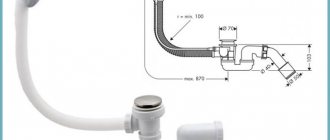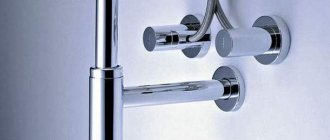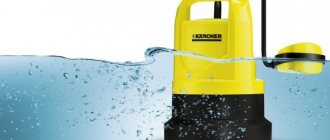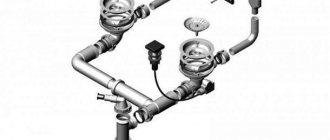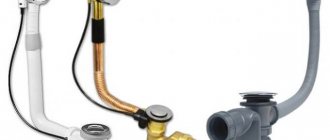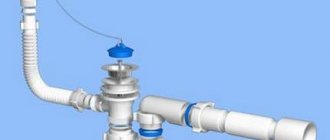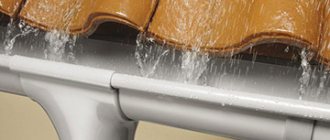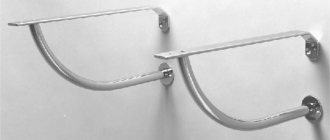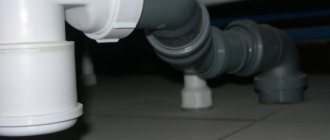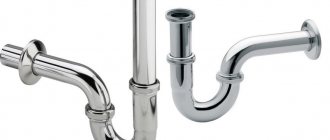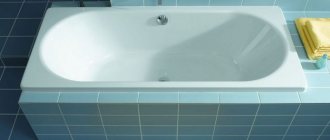Operating principle
The piping (or drain-overflow) organizes the drainage of water from the bathroom tank into the sewer pipe. The device consists of several hoses and tubes that are connected to each other, with a sewer system and two bath openings. The top hole of the tank prevents water from overflowing, the bottom hole is responsible for draining.
If all components are installed correctly, the likelihood of overflowing the bathtub is reduced to a minimum, but there must be moderation in everything. Sometimes water fills the bowl faster than it drains, in which case you can flood the floor in the room.
Selection of a new siphon
When replacing or initially installing, it is important to select the correct device. The easiest way is to take an old siphon to the store and choose a model that is as similar in characteristics as possible. Otherwise, you will have to select a siphon, having previously carried out the necessary measurements. You definitely need to know:
- Drain hole diameter.
- Overflow hole diameter.
- Distance between the floor and the installed bathtub. It should not be less than 15 cm.
Buying the simplest and cheapest models of siphons will not be difficult, but they will not always last a long time and without leaks. More expensive, but high-quality models can be found in specialized stores.
The most commonly used are plastic siphons. At a very reasonable price, they have good performance characteristics: light weight, non-corrosive. With proper assembly and maintenance of such a bath siphon, it will last quite a long time. In addition, it will not be difficult to install it on the bathtub with your own hands; just watch the video, which shows the installation process in detail.
Types and differences of devices
2.1 Standard version
Model complete set:
- Pipe (siphon). Serves as a barrier against unwanted odors entering the apartment;
- Overflow neck;
- Drain neck;
- A tube connecting the siphon to the sewer system;
- A corrugated hose that allows water to flow into a siphon.
This device is considered traditional. To fill the bathtub, close the bottom hole with a stopper.
During operation, you need to monitor the condition of the seals and replace them in a timely manner.
Price range for standard models: from 10 to 25 $.
2.2 Semi-automatic drain and overflow
This system is more advanced than the traditional one. The drain and overflow consists of tubes and hoses that drain water, a siphon, and necks, but there are differences. The semi-automatic machine is supplemented with the following elements:
- Valve plug;
- A special cable that is responsible for controlling the plug;
- The mechanism by which the plug is lowered and raised. This function can be performed by a rotary ring, a button, a valve, or a handle.
The mechanism of action is quite simple: when the cable is tensioned, the valve rises, and due to loosening, it lowers. In order for the cable to move, you need to turn the valve or press a special button. In the semi-automatic device, the overflow hole is hidden behind the control unit. The advantages of the drain and overflow also include the design and ease of use of the structure.
The disadvantage of a semi-automatic system is the degree of reliability. It is better to purchase an expensive modification, or opt for a standard model.
Prices for semi-automatic devices: from 20 to 55 $.
2.3 Automatic option
A distinctive feature of this mechanism is the valve, the action of which is automated. In order for the plug to close the drain hole in the bowl, you need to press on it. The spring compresses and lowers the valve; due to the latch, the position is maintained. In order to drain the water you need to press the button. Advantages:
- The drain can be controlled with your feet;
- Compact size of the visible part;
- Large assortment of buttons. Chrome elements are suitable for high-tech style; brass buttons will perfectly complement the vintage design.
Automatic drainage is often found in baby bath models. This device simplifies operation; the tank does not need to be turned over to remove water.
The disadvantage of this bathroom waste and overflow option is that it is difficult to replace the button. If the valve breaks, you have to purchase a new system. That is why experts recommend purchasing the most reliable automation.
Prices range on average from $60 to $280.
Manufacturers rating
- The automatic model of the Kaiser brand, produced in Germany, has won a leading position in the Russian market. The price of the structure is up to 3.0 thousand rubles.
- For buyers with average incomes, systems from the Viega and Geberit brands are offered. In terms of build quality, Geberit is inferior to Viega.
- Semi-automatic drain-overflow systems from the Abelone brand are in demand on the plumbing market. The automatic mechanism of this company can withstand 50 thousand operating cycles (the mechanism opens and closes). It is made of copper, various coatings are applied. Machine price: 3.2 – 3.5 thousand rubles.
- If you don’t want to spend money on bathtub drainage systems, then Frap brand models are ideal. The company produces budget and luxury devices. Their price: 1.0 – 3.0 thousand rubles.
- Easy to install Equation brand models. The company produces a system for both bathtubs and washbasins. Most models are made of plastic.
Types and features of materials
The main condition when choosing a material is corrosion resistance. These options include:
- Ferrous metal is a reliable material. The main drawback is the appearance of the device. Currently, they are trying to choose more modern options;
- Plastic for plumbing fixtures (polypropylene). White color, laconic shape, long service life. Polypropylene is inferior to metal in terms of strength, so there is a risk of product breakage. A simple drain and overflow design may be inappropriate if the decoration of the room involves the use of expensive materials and equipment;
- Bronze, brass or copper. Often these non-ferrous metals are not used without a protective layer. Parts located in the visible area can be coated with nickel or chromium (using the electroplating method). The use of nickel is preferable; this material is characterized by long-term operation. The visual difference of nickel is the blue tint of the parts;
In order to determine the type of metal, you should pay attention to the holes in the top and bottom of the bath. The color of copper is red; the strength characteristics of copper are inferior to other materials. Brass is stronger than copper and has a light yellow tint. The bronze base is the most durable in this category, comparable in stability to ferrous metal. Bronze is characterized by a dark brown tone; the main components of the alloy are zinc and copper. Non-ferrous metals are an excellent option for the production of plumbing fixtures. Due to the resistance to corrosion, the parts are easily connected by thread.
Be careful not to damage the protective coating of the base. Even a small scratch will cause the destruction of the entire layer in the shortest possible time. The reason for this effect is a chemical process between metals.
Installation
You can install the drain and overflow yourself, but it is important not to forget that the tightness of the bathtub in the future depends on the quality of the work. However, despite all the responsibility, installation of the system can be carried out by a non-professional; you just need to listen to the advice of specialists.
General recommendations:
- Follow a certain sequence in your work;
- Use special sealants to process connections;
- When tightening parts, be careful not to strip the threads;
- All elements must be tightened one quarter of a full turn after hand tightening;
- If you cannot tighten the connection, you need to check whether the nut is level.
Installation begins after the bowl is secured to the support. The bathtub must be leveled and fixed. It is also necessary to leave a height gap between the floor and the tank (from 150 mm or more).
Correct sequence:
- The bottom hole of the bathtub is connected to a tee. In this case, you need to process the connection using a sealant and secure the elements with a screw;
- Next, attach the siphon and secure it with the tee outlet with a nut. A rubber cuff can be used as a seal here;
- The overflow neck is connected to a side curved tube (siphon);
- The process is completed by connecting the siphon to the sewer pipe. For this purpose, a special spout pipe is used;
- During each connection, you should remember to lay the seal.
After installation is complete, you need to check the bathtub for leaks. The bowl is filled with water, then you need to carefully examine all the joints and connections. If drops appear on the surface, tighten the elements more tightly and re-treat with sealant.
Siphon installation video:
How to install the drain mechanism yourself?
What do you need to know to install it yourself?
First, you should carefully read the instructions and all documentation included with the kit: all installation recommendations must be strictly followed, otherwise the mechanism will not work correctly or will not work at all.
An important installation point is that the hole for the drain should not be lower than fifteen centimeters from the surface on which the bathtub itself is installed.
Pay attention to the stability of the container - the bathtub should not wobble, especially for acrylic and metal bowls, which have little weight and, as a result, poor stability.
Then a special tee should be attached to the decorative grate of the drain hole. The connection is carefully treated with sealant or additionally covered with gasket material. The siphon is mounted on the lower end of the tee, and a connecting tube is attached to its side.
The next stage of installation work is to attach an angle to the tee, which will connect the mechanism to the sewer. Do not forget that each connection in the installation of an overflow drain requires treatment with a sealant and mandatory inspection before drawing water. To do this, you need to fill the bowl with a little water and then perform a test drain. If there is no water leakage, the mechanism is installed correctly and is ready for operation.
Metal drains should be installed carefully and without sudden movements - they are not very flexible and can burst if bent too much.
Care Tips
There are no strict rules for operating the drain and overflow. Let's look at some tips for caring for this system:
- For automatic and semi-automatic devices, it is necessary to periodically process the parts to maintain the shine of the metal. Such care is carried out using glass cleaners or special products;
- Carry out regular inspections to identify possible leaks;
- If the seal is broken, you can replace the sealing material, or tighten the junction of the elements additionally;
- Siphon clogging is considered one of the most common problems in the operation of this system. Cleaning is carried out with a small brush attached to a wire or using a plunger;
- An alternative to mechanical cleaning is chemical treatment using special means. The alkali in such products helps neutralize the blockage due to its splitting effect;
- These measures can be applied not only to the problem of blockage. The best way to prevent such a problem is periodic maintenance of the system.
